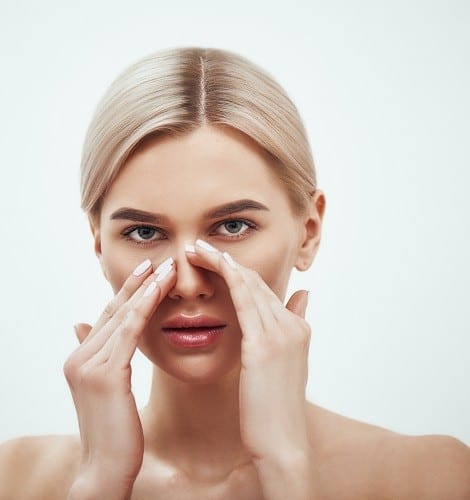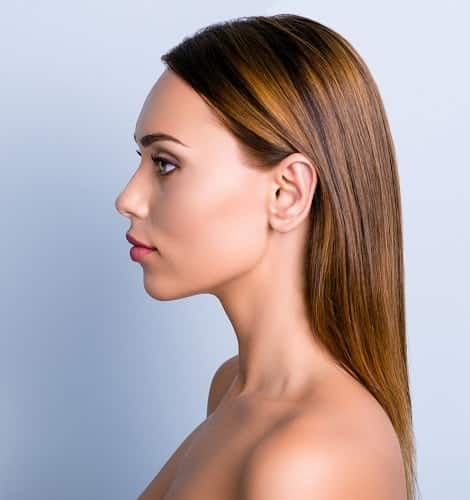Revision Rhinoplasty in San Diego
Personal Attention & Specialized Care
Revision or secondary rhinoplasty (nose job) is one of the most challenging procedures in plastic and cosmetic surgery. It requires accurate diagnosis, proper timing, extensive experience and surgical skill. Realistic expectations are paramount when performing revision or secondary rhinoplasty.
Dr. Moneer Jaibaji is a double-board-certified plastic surgeon dedicated to cosmetic and reconstructive surgery. He has extensive training from notable institutions in England and the United States and has published numerous research projects and papers in plastic surgery journals. He’s presented at medical conferences around the world. Dr. Jaibaji continues his medical education through various courses to ensure his Coronado and San Diego practice offers advanced treatments and surgical techniques.

The Timing of Your Revision Rhinoplasty
A rhinoplasty revision is usually performed one year after the primary procedure. This usually allows for the swelling and the scar tissue to subside. The longer the duration from the primary procedure the less the swelling and scarring. This also allows accurate assessment of the deformity. Rarely revision rhinoplasty is performed within a year of the primary rhinoplasty.
Rhinoplasty is a complex and challenging procedure and requires an expert surgeon who can correct deformities while preserving nasal function. Improving your nose appearance must also ensure the nasal airway functions properly. Secondary rhinoplasty, or revision rhinoplasty, makes this meticulous procedure even more complicated due to the initial changes and scar tissue from the primary surgery.
Patients who are unhappy with their rhinoplasty results or suffer functional problems due to the first procedure may require revision rhinoplasty. Scar tissue and deficient cartilage from the prior surgery are some of the concerns our plastic surgeon must address with revision rhinoplasty.
Some patients may experience a deviated septum after the initial surgery that limits nasal function and impacts the appearance of their nose. Nasal obstruction may happen if the cartilage in the nasal tip collapses or there’s insufficient upper lateral cartilage. In these cases, a cartilage graft (or spreader graft) may be necessary to open the narrow areas causing functional issues.
Patient Age: 45, Patient Height: 5.2, Patient Weight: 112 This patient had silicone nasal implant to augment the nose bridge. The procedure was performed in the far east. Initially, she was pleased with the results, but, as the swelling started to subside she noticed deformity of the nose. The implant was shifted to the right side causing widening of the nose and was giving her constant pain. She saw Dr. Jaibaji for a consultation. After complete evaluation of her nose and her goals, she elected to have a nose revision surgery. During surgery, diced cartilage graft was used to replace the silicone implant. The silicone nose implant was removed.
Reasons for Revision Rhinoplasty


How Is Revision Rhinoplasty Different from Standard Rhinoplasty?
Revision rhinoplasty is more complicated than the original procedure because the buildup of scar tissue may make it more challenging to access the nasal structures. A secondary nose surgery may be more complex than the first due to the cosmetic and/or functional problems that must be fixed. Insufficient cartilage and other tissues may require grafts to re-sculpt the nose properly.
Standard rhinoplasty often removes cartilage to augment the nasal structures. Revision rhinoplasty may need to harvest cartilage from the ear, rib or another area to make the required changes and restore nose function. Soft tissues in the nose are adjusted or removed with standard rhinoplasty, and the second surgery may need a soft tissue graft to reshape the nose. Scarring from the initial rhinoplasty may require skin grafts to reopen a narrowed or distorted nasal airway, and these are often taken from the hairline.
Some patients may still require another revision surgery to address functional or cosmetic problems but choosing a board-certified plastic surgeon with ample experience in revision rhinoplasty makes this less likely. Dr. Jaibaji has helped many patients improve their rhinoplasty results with a secondary procedure.
Open or Closed Technique for Revision Rhinoplasty

Contact Jaibaji Plastic Surgery About Revision Rhinoplasty
If you’re unhappy with your rhinoplasty results from a previous procedure, schedule a consultation with our double-board-certified plastic surgeon to discuss your case. Contact Jaibaji Plastic Surgery in Coronado, California, at (619) 522-0821 or fill out our online contact form.
Before & After
View Our GalleryCase Studies
Patient Age: 45, Patient Height: 5.2, Patient Weight: 112 This patient had silicone nasal implant to augment the nose bridge. The procedure was performed in the far east. Initially, she was pleased with the results, but, as the swelling started to subside she noticed deformity of the nose. The implant was shifted to the right side causing widening of the nose and was giving her constant pain. She saw Dr. Jaibaji for a consultation. After complete evaluation of her nose and her goals, she elected to have a nose revision surgery. During surgery, diced cartilage graft was used to replace the silicone implant. The silicone nose implant was removed.




